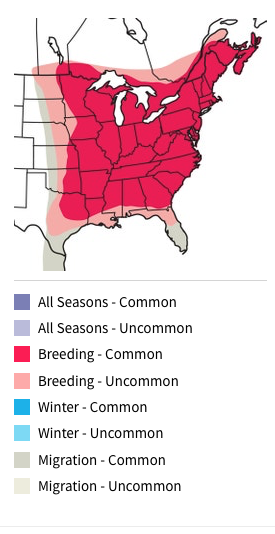The Eastern Wood-Pewee (Contopus virens) is a common summer resident across Kentucky.
Its most prominent namesake in Kentucky is Pewee Valley, in Oldham County, a beautiful community of old homes, open green space and big trees, along LaGrange Road (Ky. 146). First settled as a stop on the Louisville & Frankfort Railroad, the town became officially known as Pewee Valley, with the establishment of a U.S. Post Office there in 1856.

The Eastern Wood-Pewee is a member of family Tyrannidae, the tyrant flycatchers, one of the largest family of birds, with more than 400 species worldwide.
First identified in the scientific literature in 1760 by French zoologist Mathurin Jacques Brisson, based on a specimen collected in the Carolinas, the Eastern Wood-Pewee stands 5.3 to 5.9 inches tall, and weighs about .49 ounces. Wingspans range from 9.1 to 10.2 inches.
Both sexes look alike in size and coloration. Adults have light gray-olive upperparts, with olive-colored breasts. Each wing has two pale wing bars, and its flight feathers are long, giving the wingtip a slim and very pointed appearance. The upper part of the bill is dark, the lower part is yellowish.
In the summer woodlands, its calls — a plaintive series of whistled “pee-a-wee,” with a rising note at the end –is often heard before the bird is seen. That’s because the birds are usually somewhere in the leafy middle story of a tree, perched on a bare limb. They sing most often at dawn and dusk, and may continue singing quite late in the evening.
Range and Distribution

Across Kentucky, the Eastern Wood-Pewee is found in a wide variety of semi-open habitats, including mixed pine-hardwood forests in the Cumberland Plateau.
Understory removal, common in parks, farmlands and rural subdivisions, has created open space, which wood-pewees frequent.
In the Kentucky Breeding Bird Atlas, author Brainard Palmer-Ball Jr. wrote that the Eastern Wood-Pewee “seems to have adapted fairly well to changes in the landscape that have occurred since European settlement. Fragmentation of forested areas has created an abundance of edge habitat.”
The Eastern Wood-Pewee’s range in the Lower 48 states extends from Minnesota, south to east Texas, east along the Gulf Coast states from Louisiana to southern Georgia, north up the Atlantic Coast to Maine, and west through the Great Lakes states.
Wood-Pewees that nest in Kentucky depart for their wintering grounds in October, migrating at night. They winter in South America, and return to Kentucky in early May.
Food Habits
The Eastern Wood-Pewee captures small flying insects, darting out from a perch amid tree branches.
According to one study, they make an average of 36 flights per hour during the non-breeding season and almost twice as many, when feeding young.
They also eat insects found on foliage or on the ground, taking advantage of locally abundant prey during insect emergences. Their diet includes flies, bugs, butterflies, moths, bees, wasps, beetles, grasshoppers, crickets, stoneflies, and mayflies.
Wood-pewees also eat small amounts of vegetable matter, including the berries and seeds of dogwood and poison ivy.
Courtship and Nesting

Eastern Wood-Pewees are territorial during the breeding season.
Their territories range from about five to 20 acres in size. The male changes his singing patterns in response to other males. He also attacks other species that approach while he is singing.
Pewees are monogamous. The female incubates the brood while the male brings food. They are solitary during migration and on the wintering grounds.
Nest building begins in late May and extends into early June. Re-nesting, if their nest is lost to predation or storms, occurs in early August. Some pairs nest twice.

Eastern Wood-Pewees nest in trees and saplings. Their nests are typically 15 to 50 feet off the ground.
The nest is shallow and compact, a small cup made of woven plant material. and covered with lichens that provide superb camouflage.
The clutch size is typically two to four white or creamy eggs, with a wreath of brown or purple speckles.
The incubation period is 12 to 14 days, with the young staying in the nest for 16 to 18 days, while they are helpless, with sparse down feathers and closed eyes.
Conservation
The Eastern Wood-Pewee is a fairly common bird in Kentucky and of least conservation concern, but across its range in the Lower 48 states and southern Canada, populations have declined by about one percent per year for a cumulative decline of about 44 percent between 1966 and 2019, according to the North American Breeding Bird Survey.
This alluring bird, with such a distinctive song, is a native species that has fascinated Kentuckians since early settlement.


















